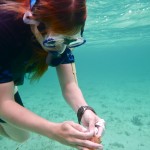
Due to overfishing for food and export, The Bahamas are one of the only countries with a large population of queen conch left, and we are very keen to try and protect them as best we can. One major issue is the lack of enforcement, with juveniles being fished illegally throughout South Eleuthera. Removing juveniles means they never have a chance to reproduce, and the population suffers.

To try and understand how the local population is doing at the moment, the conch team (consisting of Newcastle undergraduate Rey and conch intern Holly, with the help of others!) has been conducting snorkel surveys of the shallow areas off Cape Eleuthera, which have been shown to be nurseries for juvenile conch. The data will be compared to a study that was done in 2003 (Clark et al. 2005) in order to get a 10 year comparison, and an idea of how the population is responding to the increased fishing pressure of the last decade. Ideally, this data will be used by the Bahamian government to protect areas we are designating as important nursery grounds, to prevent the continued fishing of juveniles. It is important to protect all stages of the life cycle in order to conserve this species as best we can.